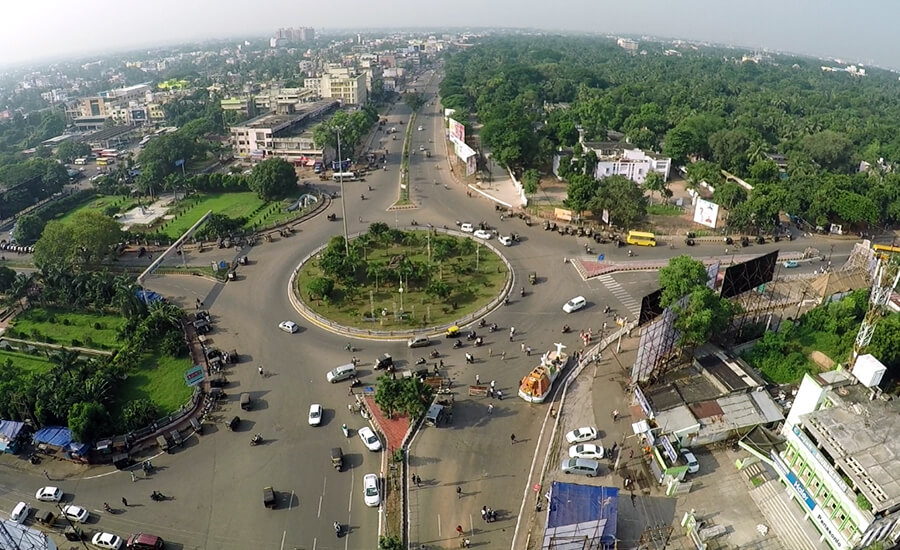The Fall Of Bhubaneswar’s Tahrir Square

The world gears up for World Cities Day, along with searching for green tools to deal with climate crisis, with the belief that climate change is a global problem that requires a global solution. But it is also believed that cities hold the nerve to climate solutions.
Not every city, however, understands its role in this road map. Bhubaneswar joins the club of cities which knowingly left the bus as it passed.
People who have been born this millennium won’t ever know how close people were to the power corridor of Odisha. They will never believe their ancestors were once able to walk between State Secretariat (now called Lok Sewa Bhavan) and State Assembly, and one road behind State Assembly by making a circular path. A walk which would make one feel the closeness of being inside temples of democracy in those few kilometres during morning, evening or afternoon.
If they don’t remember those streets of democracy now flattened to pave way for concrete structure, then they will little understood what really happened in Bhubaneswar. The adventure of making Temple city of Bhubaneswar look like a cosmopolitan city is certainly not what modern urban planning is all about.
Interestingly, curfew was extended by 2 hours, beginning at 8 pm, halfway into autumn festive season. So citizens thinking of shopping, pandal-hopping, dining out or enjoying immersion Durga idols like a carnival at Janpath as well as Master canteen roundabout don’t get surprised. The silence in festival season just smashed many of the present-day youths’ childhood journey.
But whatever happened, was it an outcome of Participatory Urban Planning? Certainly not. Yes, the roundabout does cause congestion but what it also does is reduce collisions and that’s what a good city does for its people. The government should have saved the remaining roundabouts if it cannot make more because they are the identity of Bhubaneswar and are almost like heritage property.
These roundabouts once made Bhubaneswar one of the most beautiful cities in India for quite some time around the millennium. Now, it is a busy crowded place with very little room for visions and dreams, yet a city with sincere hidden beauty.
Master Canteen is the backbone of Odisha’s political history and therefore reviving its urban morphology is a political, environmental and social desideratum. However the Smart City project design, an amalgamation of multiple projects, ignored the basics of the site that include memorial, recreational area and commercial space.
City planners could have spent some time using participatory planning tools on what to do with the square. Contrary to that, the vision behind the present design proposal involves an overhaul of the entire area that not only erodes its past revolutionary essence, but also smashes the existing recreational breather in the midst of one of the most vibrant places of Bhubaneswar.
Ever since its inception in the late 80s, Master Canteen roundabout has been a topic of much debate between those in Government and those protesting for their rights as a gathering place to show solidarity. Yet, from Egypt’s Tahrir Square to Tunisia’s central Bourguiba Avenue, the plazas of Syria’s ancient cities, India Gate in New Delhi’s Janpath, Gateway of India in Mumbai, to Master Canteen Mahatma Gandhi Road in Bhubaneswar, public squares have been at the centre of revolutions.
But the centrality of these places to the narrative of uprisings has largely been overshadowed by the role that a Government is expected to play in safeguarding the rights of their citizens instead of demolishing the site in the name of modernity. Then why is the ruined structure standing between those making their dream of highway inside city to facilitate more automobile and concrete culture around the roundabout with tall palm trees and some ornamental rock carved structures?
Interestingly, this horse-shaped state emblem made of rock is neither a heritage nor something that the city should celebrate in future, but is a piece which suggests it survived a tsunami and has been left for future generations to explore how their Bhubaneswar was in the 90s. It’s a process that without anyone’s touch the structure will collapse or simply erode, just like what’s happening in New Delhi with Central Vista project.
Dutch car fatality rate was once said to be higher than America’s, but now it’s one-third of it. It’s due to the fact that street design is more important than speed limit. When you have a big, wide, straight road in the middle of the city, you’re going to drive faster. That’s where Bhubaneswar invited trouble for its seniors, youths, women, children.
The question is, where is Bhubaneswar heading? It’s neither respecting its own urban planning, nor jumping into fully American way or leapfrogging into European-based city planning. Rather, it’s venturing into something damaging for the city.
The quest to become a Smart City had flattened the last-but-one roundabout as part of its dream of two popular persons — one present Prime Minister and another Chief Minister of Odisha.
Interestingly, the flattening of roundabouts is a rather old concept in the state capital to deal with traffic congestion. Even in the past, roundabouts have been done away with to make way for wider roads and bigger traffic junctions.
Unfortunately, the beauty of these roundabouts have been undermined and the authorities found easier solutions to deal with pedestrians, cyclists and motorists. It is a pity that the city is trading off its roundabouts for wider roads, despingte overbridges.
Well no one was able to save roundabouts in the last 20 years of Bhubaneswar’s world-class journey. So will the next massacre likely to be Governor House Square and Gopabaandhu Chhaka, the last remaining roundabouts? The world still loves those roundabouts, the reason they love their people and not highways inside cities, that would kill people.
Further, a roundabout with trees benefits the city with cool air, removing pollutants, absorb carbon, Increasing biodiversity, improving health and increasing value of property.

Comments are closed.